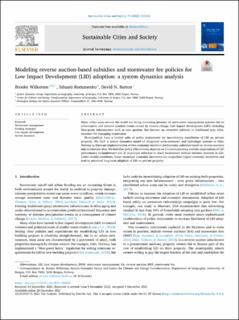| dc.contributor.author | Wilkerson, Brooke E | |
| dc.contributor.author | Romanenko, Eduard | |
| dc.contributor.author | Barton, David Nicholas | |
| dc.coverage.spatial | Oslo, Norway | en_US |
| dc.date.accessioned | 2023-01-05T12:44:37Z | |
| dc.date.available | 2023-01-05T12:44:37Z | |
| dc.date.created | 2022-01-18T15:34:33Z | |
| dc.date.issued | 2022 | |
| dc.identifier.issn | 2210-6707 | |
| dc.identifier.uri | https://hdl.handle.net/11250/3041246 | |
| dc.description.abstract | Many urban areas around the world are facing increasing pressure on stormwater management systems due to urbanization and extreme weather events caused by climate change. Low impact development (LID), including blue-green infrastructure such as rain gardens, has become an attractive addition to traditional gray infrastructure for managing stormwater. Municipalities have a limited suite of policy instruments for incentivizing installation of LID on private property. We built a system dynamics model of integrated socio-economic and hydrologic systems in Oslo, Norway to illustrate implementation of two economic incentive mechanisms: subsidies based on reverse auctions and stormwater fees. We find that policy effectiveness depends on 1) communicating realistic expectations of LID performance to landowners and 2) municipal subsidies to reach landowners without intrinsic interests in LID. Under certain conditions, lower municipal economic incentives can outperform higher economic incentives and lead to sustained long-term adoption of LID on private property. Stormwater managementFunding strategiesLow impact developmentSystem dynamics | en_US |
| dc.language.iso | eng | en_US |
| dc.rights | Navngivelse 4.0 Internasjonal | * |
| dc.rights | Navngivelse 4.0 Internasjonal | * |
| dc.rights.uri | http://creativecommons.org/licenses/by/4.0/deed.no | * |
| dc.subject | Stormwater management | en_US |
| dc.subject | Funding strategies | en_US |
| dc.subject | Low impact development | en_US |
| dc.subject | System dynamics | en_US |
| dc.title | Modeling reverse auction-based subsidies and stormwater fee policies for Low Impact Development (LID) adoption: a system dynamics analysis | en_US |
| dc.type | Peer reviewed | en_US |
| dc.type | Journal article | en_US |
| dc.description.version | publishedVersion | en_US |
| dc.rights.holder | © 2021 The Authors | en_US |
| dc.subject.nsi | VDP::Samfunnsgeografi: 290 | en_US |
| dc.subject.nsi | VDP::Human geography: 290 | en_US |
| dc.subject.nsi | VDP::Samfunnsvitenskap: 200::Økonomi: 210::Samfunnsøkonomi: 212 | en_US |
| dc.source.volume | 79 | en_US |
| dc.source.journal | Sustainable Cities and Society (SCS) | en_US |
| dc.identifier.doi | 10.1016/j.scs.2021.103602 | |
| dc.identifier.cristin | 1983863 | |
| dc.relation.project | Norges forskningsråd: 270742 | en_US |
| dc.source.articlenumber | 103602 | en_US |
| cristin.ispublished | true | |
| cristin.fulltext | original | |
| cristin.qualitycode | 1 | |

